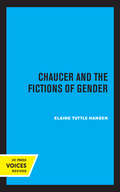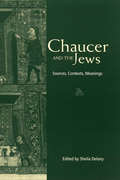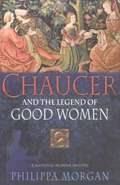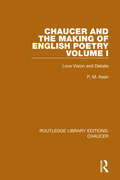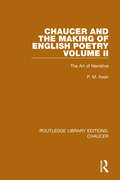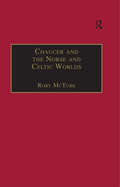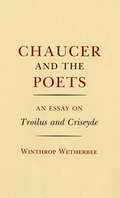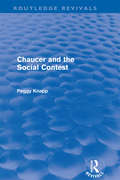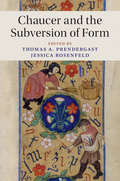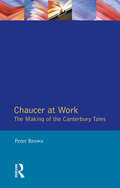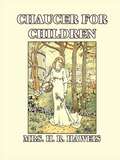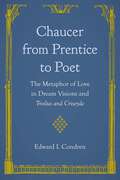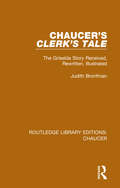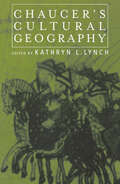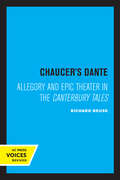- Table View
- List View
Chaucer and the Fictions of Gender
by Elaine Tuttle HansenThis title is part of UC Press's Voices Revived program, which commemorates University of California Press’s mission to seek out and cultivate the brightest minds and give them voice, reach, and impact. Drawing on a backlist dating to 1893, Voices Revived makes high-quality, peer-reviewed scholarship accessible once again using print-on-demand technology. This title was originally published in 1992.
Chaucer and the Jews (Multicultural Middle Ages Ser.)
by Sheila DelanyThis edited collection explores the importance of the Jews in the English Christian imagination of the 14th and 15th centuries - long after their expulsion from Britain in 1290.
Chaucer and the Legend of Good Women: A Medieval Murder Mystery
by Philippa MorganThree years after his secret mission to Aquitaine, the poet and diplomat Geoffrey Chaucer finds himself once more embarked on royal business. After an arduous journey in the spring of 1373, he reaches Florence, a city twice the size of London and the banking center of Europe. Chaucer has come for money for Edward III, who needs a loan to prop up the ongoing English campaign against France. Arrangements have been made with the banking house run by Antonio Lipari. It should be a straightforward exchange, but Chaucer soon discovers that various people are opposed to the deal, including Lipari's blind brother and his ambitious secretary. Within days Antonio Lipari has died in suspicious circumstances. Violence is bubbling under the surface of this city of stone towers and golden vistas. Outside the walls is camped a band of English mercenaries while, inside, Chaucer himself is aware of shadowy pursuers. Following a trail of fish and the clues provided by a fallen statue, Chaucer must establish the truth about Lipari¹s death and others before he can return home to England. Meanwhile back in London, Chaucer's wife suspects a plot against her sister Katherine--one of the most powerful women in England.
Chaucer and the Making of English Poetry, Volume 1: Love Vision and Debate (Routledge Library Editions: Chaucer)
by P. M. KeanOriginally published in 1972. This important work of Chaucerian scholarship deals with two aspects of the poet and his work - his individual achievement and his place in history - and demonstrates that in both these senses Chaucer is a maker of English poetry. The author assesses the extent of Chaucer’s debt to the English tradition. She considers the development of his ‘urbane’ manner as a new poetic technique and, with reference to such poems as the Parlement of Foules and the House of Fame, discusses new themes in the Love Vision. She concludes with a detailed study of Chaucer’s great debate on love Troilus and Criseyde.
Chaucer and the Making of English Poetry, Volume 2: The Art of Narrative (Routledge Library Editions: Chaucer)
by P. M. KeanOriginally published in 1972. This important work of Chaucerian scholarship deals with two aspects of the poet and his work - his individual achievement and his place in history - and demonstrates that in both these senses Chaucer is a maker of English poetry. The author explores Chaucer’s narrative art. The book includes an examination of the puzzling question of narrative structure in the Canterbury Tales and of the nature of Chaucerian comedy in these works. The author surveys the major themes of the poems: Fortune and free will, marriage, and the nobleness of man. In the final chapter she treats of the meaning of Chaucer’s art for his successors. Throughout the work, Miss Kean deals extensively with the sources which Chaucer used for the writing of his poems, in a way which directs light on the more difficult aspects of his art.
Chaucer and the Norse and Celtic Worlds
by Rory McTurkThrough an examination of Old Norse and Celtic parallels to certain works of Chaucer, McTurk here identifies hitherto unrecognized sources for these works in early Irish tradition. He revives the idea that Chaucer visited Ireland between 1361 and 1366, placing new emphasis on the date of the enactment of the Statute of Kilkenny. Examining Chaucer’s House of Fame, McTurk uncovers parallels involving eagles, perilous entrances, and scatological jokes about poetry in the Topographia Hibernie by Gerald of Wales, Snorri Sturluson’s Edda, and the Old Irish sagas Fled Bricrend and Togail Bruidne Da Derga. He compares The Canterbury Tales, with its use of the motif of a journey as a framework for a tale-collection, with both Snorri’s Edda and the Middle Irish saga Acallam na Senórach. McTurk presents a compelling argument that these works represent Irish traditions which influenced Chaucer’s writing. In this study, McTurk also argues that the thirteenth-century Icelandic Laxdæla Saga and Chaucer’s Wife of Bath’s Prologue and Tale each descend from an Irish version of the Loathly Lady story. Further, he surmises that Chaucer’s five-stress line may derive from the tradition of Irish song known as amhrán, which, there is reason to suppose, existed in Ireland well before Chaucer’s time.
Chaucer and the Poets: An Essay on Troilus and Criseyde
by Winthrop WetherbeeIn this sensitive reading of Chaucer’s Troilus and Criseyde, Winthrop Wetherbee redefines the nature of Chaucer’s poetic vision. Using as a starting point Chaucer’s profound admiration for the achievement of Dante and the classical poets, Wetherbee sees the Troilus as much more than a courtly treatment of an event in ancient history—it is, he asserts, a major statement about the poetic tradition from which it emerges. Wetherbee demonstrates the evolution of the poet-narrator of the Troilus, who begins as a poet of romance, bound by the characters’ limited worldview, but who in the end becomes a poet capable of realizing the tragic and ultimately the spiritual implications of his story.
Chaucer and the Social Contest (Routledge Revivals)
by Peggy KnappFirst published in 1990, Chaucer and the Social Contest takes a fresh view of The Canterbury Tales, by placing the storytelling contest among the Canterbury pilgrims within the larger social contests in the changing England of the late fourteenth century. The author focuses on three crucial fields of contention: the division of social duties into the three estates, the controversies around Wycliffite thought and practice, and the roles of women. Drawing on recent literary theory, particularly Bakhtin and Foucault, Peggy Knapp offers both a reading of nearly all the tales and an argument about how such readings come about, both for Chaucer’s earliest audiences and for us.
Chaucer and the Subversion of Form (Cambridge Studies in Medieval Literature #104)
by Jessica Rosenfeld Thomas A. PrendergastResponding to the lively resurgence of literary formalism, this volume delivers a timely and fresh exploration of the works of Geoffrey Chaucer. Advancing 'new formalist' approaches, medieval scholars have begun to ask what happens when structure fails to yield meaning, probing the very limits of poetic organization. While Chaucer is acknowledged as a master of form, his work also foregrounds troubling questions about formal agency: the disparate forces of narrative and poetic practice, readerly reception, intertextuality, genre, scribal attention, patronage, and historical change. This definitive collection of essays offers diverse perspectives on Chaucer and a varied analysis of these problems, asking what happens when form is resisted by author or reader, when it fails by accident or by design, and how it can be misleading, errant, or even dangerous.
Chaucer at Work: The Making of The Canterbury Tales
by Peter BrownChaucer at Work is a new kind of introduction to the Canterbury Tales. It avoids excessive amounts of background information and involves the reader in the discovery of how Chaucer composed his famous work. It presents a series of sources and contexts to be considered in conjunction with key passages from Chaucer's poems. It includes sets of questions to encourage the reader to examine the text in detail and to build on his or her observations. This well-informed and practical guide will prove invaluable reading to those studying medieval literature at undergraduate level and English literature at A level.
Chaucer for Children: A Golden Key
by H. HaweisIllustrated with pictures and woodcuts by the authorA beautifully laid out—and perfectly accurate to the original—copy of one of the most famous books on how to teach Chaucer to children ever issued. Despite its name, this work is directed at explaining and teaching Chaucer—and is equally presentable to both youngsters and adults.This book, and its author, Mary Eliza Haweis (who wrote using her married name), are widely credited with reviving Chaucer’s poetry in the modern world.These stories from The Canterbury Tales, along with some of Chaucer’s shorter poems, were the first to be presented in their original Middle English format alongside contemporary English.
Chaucer from Prentice to Poet: The Metaphor of Love in Dream Visions and Troilus and Criseyde
by Edward I. CondrenA comprehensive reevaluation of Chaucer's early poetry, from the "dream visions" to Troilus and CriseydeWhile covering all the major work produced by Geoffrey Chaucer in his pre-Canterbury Tales career, Chaucer from Prentice to Poet seeks to correct the traditional interpretations of these poems. Edward Condren provides new and provocative interpretations of the three "dream visions"—Book of the Duchess, Parliament of Fowls, and House of Fame—as well as Chaucer's early masterwork Troilus and Criseyde. Condren draws an arresting series of portraits of Chaucer as glimpsed in his work: the fledgling poet seeking to master the artificial style of French love poetry; the passionate author attempting to rebut critics of his work; and, finally, the master of a naturalistic style entirely his own. This book is one of the few works written in the past century that reevaluates Chaucer's early poetry and the only one that examines the Dream Visions in conjunction with the Troilus.It should frame the discourse of Chaucer scholarship for many generations to come.
Chaucer's Clerk's Tale: The Griselda Story Received, Rewritten, Illustrated (Routledge Library Editions: Chaucer)
by Judith BronfmanOriginally published in 1994. This surveys the origin and development of one of Chaucer’s most problematic characters, Griselda, who through the centuries has challenged the horizon of expectations of many an audience. Starting with Boccaccio’s Decameron and suggesting in turn its precursors in whole or in part, Bronfman goes on to summarize the reigning opinions of Chaucer’s heroine and her situation. The advance of feminist perspectives on medieval literature had the result that for many the Clerk’s Tale has political overtones where the Walter-Griselda marriage may serve as a metaphor for, among other things, the state or right order. This study looks at the story from a long view, from its sources to the flood of critical interpretations - the creative reception of Chaucer’s story, outlining the many rewritings of Griselda from Chaucer to the twentieth century. A special chapter considers the Griselda story as represented in illustrations as well.
Chaucer's Cultural Geography: Chaucer's Cultural Geography (Basic Readings in Chaucer and His Time #5)
by Kathryn L. LynchFirst published in 2002. Routledge is an imprint of Taylor & Francis, an informa company.
Chaucer's Dante: Allegory and Epic Theater in the Canterbury Tales
by Richard NeuseRichard Neuse here explores the relationship between two great medieval epics, Dante's Divine Comedy and Chaucer's Canterbury Tales. He argues that Dante's attraction for Chaucer lay not so much in the spiritual dimension of the Divine Comedy as in the human. Borrowing Bertolt Brecht's phrase "epic theater," Neuse underscores the interest of both poets in presenting, as on a stage, flesh and blood characters in which readers would recognize the authors as well as themselves. As spiritual autobiography, both poems challenge the traditional medieval mode of allegory, with its tendency to separate body and soul, matter and spirit. Thus Neuse demonstrates that Chaucer and Dante embody a humanism not generally attributed to the fourteenth century. This title is part of UC Press's Voices Revived program, which commemorates University of California Press’s mission to seek out and cultivate the brightest minds and give them voice, reach, and impact. Drawing on a backlist dating to 1893, Voices Revived makes high-quality, peer-reviewed scholarship accessible once again using print-on-demand technology. This title was originally published in 1991.
Chaucer's Dead Body: From Corpse to Corpus
by Thomas A. PrendergastFirst published in 2004. Routledge is an imprint of Taylor & Francis, an informa company.
Chaucer's Dream Poetry (Longman Annotated Texts)
by Helen Phillips Nick HavelyDream literature is regarded as one of the most important genres in medieval literature and is widely studied. This text provides a succinct and clear introduction to the five central poems that comprise Chaucer's Dream Poetry, and shows his role as a leading adapter of European Literary tradition into English Literature. The poems discussed are The Book of the Duchess, The Legend of Good Women, The Legend of Dido, The Parliament of Fowls and The House of Fame. Each have an introduction setting the poem within the context of Dream Poetry and Chaucer's own work. Appendices of proper names, pronunciation and criticism are also given. This volume is unique is presenting the poems together in an editorial and critical framework. The quality of annotation is unrivalled and will make this text a major addition to the literature suitable for those interested in the genre, literary, or more general history of the period.
Chaucer's Early Modern Readers: Reception in Print and Manuscript
by Devani SinghThe first extended study of the reception of Chaucer's medieval manuscripts in the early modern period, this book focuses chiefly on fifteenth-century manuscripts and discusses how these volumes were read, used, valued, and transformed in an age of the poet's prominence in print. Each chapter argues that patterns in the material interventions made by readers in their manuscripts – correcting, completing, supplementing, and authorising – reflect conventions which circulated in print, and convey prevailing preoccupations about Chaucer in the period: the antiquity and accuracy of his words, the completeness of individual texts and of the canon, and the figure of the author himself. This unexpected and compelling evidence of the interactions between fifteenth-century manuscripts and their early modern analogues asserts print's role in sustaining manuscript culture and thus offers fresh scholarly perspectives to medievalists, early modernists, and historians of the book. This title is also available as open access on Cambridge Core.
Chaucer's Early Poetry (Routledge Revivals)
by Wolfgang ClemenFirst published in 1963, this book provides an account of Chaucer’s poetry written before The Canterbury Tales. W. H. Clemen gives full, comprehensive and intriguing accounts of three major poems including The Book of the Duchess, The House of Fame, and The Parliament of Fowls in addition to some other, more minor poems from Chaucer’s oeuvre.
Chaucer's Humor: Critical Essays (Routledge Library Editions: Chaucer)
by Jean E. JostOriginally published in 1994. Chaucer is considered the first major humorist in English literature and is particularly interesting as he reflects the humor of predecessors and contemporaries as well as defines development for subsequent British humor. This collection presents essays that define the nature of Chaucerian humor, examine Chaucer’s works from a variety of theoretical perspectives, and consider genres of humor within his writing. This is an excellent work of critical discourse that adds important understanding of Chaucer as well as the field of comedy in literature.
Chaucer's Losers, Nintendo's Children, and Other Forays in Queer Ludonarratology (Frontiers of Narrative)
by Tison PughTison Pugh examines the intersection of narratology, ludology, and queer studies, pointing to the ways in which the blurred boundaries between game and narrative provide both a textual and a metatextual space of queer narrative potential. By focusing on these three distinct yet complementary areas, Pugh shifts understandings of the way their play, pleasure, and narrative potential are interlinked. Through illustrative readings of an eclectic collection of cultural artifacts—from Chaucer&’s Canterbury Tales to Nintendo&’s Legend of Zelda franchise, from Edward Albee&’s dramatic masterpiece Who&’s Afraid of Virginia Woolf? to J. K. Rowling&’s Harry Potter fantasy novels—Pugh offers perspectives of blissful ludonarratology, sadomasochistic ludonarratology, the queerness of rules, the queerness of godgames, and the queerness of children&’s questing video games. Collectively, these analyses present a range of interpretive strategies for uncovering the disruptive potential of gaming texts and textual games while demonstrating the wide applicability of queer ludonarratology throughout the humanities.
Chaucer's Monk's Tale and Nun's Priest's Tale
by Peter GoodallOf all the stories that comprise The Canterbury Tales, certain ones have attracted more attention than others in terms of literary scholarship and canonization. The Monk's Tale, for instance, was popular in the decades after Chaucer's death, but has since suffered critical neglect, particularly in the twentieth century. The opposite has occurred with the Nun's Priest's Tale, which has long been one of the most popular and widely discussed of the tales, cited by some critics as the most essentially 'Chaucerian' of them all. This annotated bibliography is a record of all editions, translations, and scholarship written on The Monk's Tale and the Nun's Priest's Tale in the twentieth century with a view to revisiting the former and creating a comprehensive scholarly view of the latter. A detailed introduction summarizes all extant writings on the two tales and their relationship to each other, giving a sense of the complexity of Chaucer's seminal work and the unique function of its component stories. By dealing with these two tales in particular, this bibliography suggests the complicated critical reception and history of The Canterbury Tales.
Chaucer's People: Everyday Lives In Medieval England
by Liza PicardThe Middle Ages re-created through the cast of pilgrims in The Canterbury Tales. Among the surviving records of fourteenth-century England, Geoffrey Chaucer’s poetry is the most vivid. Chaucer wrote about everyday people outside the walls of the English court—men and women who spent days at the pedal of a loom, or maintaining the ledgers of an estate, or on the high seas. In Chaucer’s People, Liza Picard transforms The Canterbury Tales into a masterful guide for a gloriously detailed tour of medieval England, from the mills and farms of a manor house to the lending houses and Inns of Court in London. In Chaucer’s People we meet again the motley crew of pilgrims on the road to Canterbury. Drawing on a range of historical records such as the Magna Carta, The Book of Margery Kempe, and Cookery in English, Picard puts Chaucer’s characters into historical context and mines them for insights into what people ate, wore, read, and thought in the Middle Ages. What can the Miller, “big…of brawn and eke of bones” tell us about farming in fourteenth-century England? What do we learn of medieval diets and cooking methods from the Cook? With boundless curiosity and wit, Picard re-creates the religious, political, and financial institutions and customs that gave order to these lives.
Chaucer's Poetic Alchemy: A Study of Value and its Transformation in The Canterbury Tales (Routledge Library Editions: Chaucer)
by Sheila FisherOriginally published in 1988. The economic changes and the growth of commerce in fourteenth century England precipitated both social changes and a preoccupation with material wealth. This book examines Chaucer's treatment of economic and ethical value in The Canterbury Tales within the context of contemporary economic and social change and in relation to the scholastic economic theory that attempted to formulate ethical standards for commercial conduct. The importance of value and its determination and transformation is evident from the two enterprises that Chaucer defines as the motivating principles for his poem. The pilgrimage to St. Thomas's shrine should effect a transformation of their spiritual value. The story-telling competition that produces the tales themselves is established to judge the value of the pilgrims' literary productions. In the Middle Ages, economic value and ethical value were not perceived as unrelated phenomena. Chaucer's concern with the interrelationship of material and moral value is apparent in the number of pilgrims who are interested in material value at the obvious expense of moral value. This book examines this along with a discussion or money's growing importance in the late Middle Ages and the determination of its value.
Chaucer's Queens: Royal Women, Intercession, and Patronage in England, 1328–1394 (Queenship and Power)
by Louise TingleThis book investigates the agency and influence of medieval queens in late fourteenth-century England, focusing on the patronage and intercessory activities of the queens Philippa of Hainault and Anne of Bohemia, as well as the princess Joan of Kent. It examines the ways in which royal women were able to participate in traditional queenly customs such as intercession, and whether it was motherhood that gave power to a queen. This study focuses particularly on types of patronage, and also considers the importance of coronation, especially for Joan of Kent, who was neither a queen consort nor a dowager, yet still fulfilled some queenly duties. Crucially, the author highlights the transactional nature of the queen’s role at court, as she accumulated wealth from land, rights and traditions, which in turn funded patronage activities.
